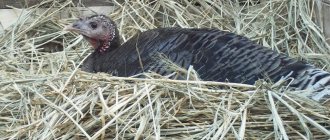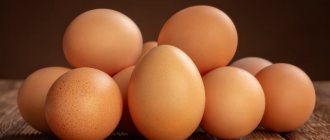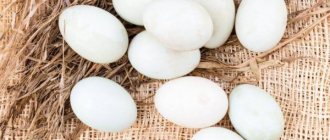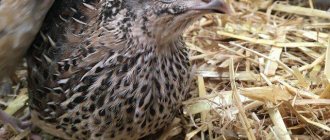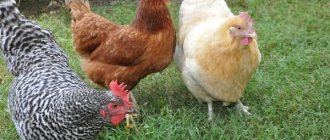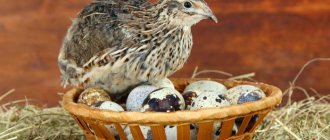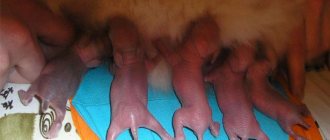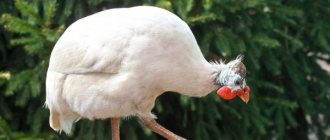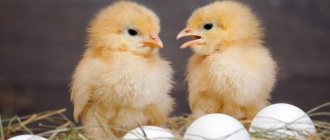Poultry farming » Guinea fowl
0
3036
Article rating
Kira Stoletova
When guinea fowls begin to lay eggs and in what quantities depends entirely on the conditions of keeping and feeding the birds, so you need to know how to provide guinea fowls with proper care. You can build a good business by breeding guinea fowl.
When do guinea fowls start laying eggs?
Guinea fowl, or, as they are also called, royal chickens, are the closest relatives of domestic chicken. In the wild, these motley birds have darker plumage, but domestic birds have a higher egg production.
When does egg laying begin?
The sexual maturity of guinea fowl is not tied to the time of year. It may occur during the cold season, but full-fledged egg laying will begin only with the onset of spring. In practice, maturation of females occurs in the 6-9th month.
The timing is influenced by the following factors:
- how comfortable conditions are created for the bird;
- how nutritious and varied the diet is;
- poultry house lighting and other factors.
The start of oviposition depends on a combination of factors influencing puberty - it usually occurs in the first or second half of spring.
Guinea fowl is a poultry that, under favorable conditions, is characterized by high egg production. With proper maintenance and feeding, the “royal bird” can become a profitable business.
Males are late in maturation; it occurs at 10-11 months. Therefore, males of the same age cannot fertilize females who reach sexual maturity 3-4 months earlier. If young laying hens are already laying eggs, and there are no mature males in the house, the eggs will be unfertilized - not suitable for breeding.
The benefits and harms of guinea fowl eggs
Guinea fowl eggs compare quite favorably with other poultry due to their excellent taste. In addition, they can be stored for a long time before being placed in the incubator. In addition, guinea fowl eggs have many other beneficial properties.
Beneficial properties of guinea fowl eggs
- Unlike chicken eggs, guinea eggs are hypoallergenic. And since whites or yolks are used in a huge number of dishes, it is invaluable for people with such allergies.
- Guinea fowl eggs contain a high content of highly digestible protein, the benefits of which are beyond doubt.
- They contain a very small amount of cholesterol and the yolks can be consumed not as limited as chicken yolks.
- They have a strong shell that protects against infection by salmonella and other viruses dangerous to humans.
One of the main beneficial properties of guinea fowl eggs is that they have universal dietary properties. Therefore, they are often included in various diets for weight loss, used by athletes, as well as people after illness.
Guinea fowl eggs can be eaten raw, unlike chicken eggs. In this form, they are most useful, increase endurance, and reduce fatigue. In terms of the content of useful substances, they are far ahead of many others.
Guinea fowl eggs have a lot of beneficial properties, however, even they can be harmful. The cause of possible harm is the high concentration of protein in the product. Despite its good digestibility, which cannot cause harm to a healthy body, it can cause harm to people with kidney and liver diseases, or individual intolerance to the product.
Otherwise, their benefits are very high and they are highly recommended for everyone from small children to adults.
Features of egg production of guinea fowl
Guinea fowl are characterized by growing clutches. This means that the process of laying eggs is dynamically changing towards an increase. It looks something like this:
- Having reached sexual maturity, females lay eggs at intervals of one day.
- After a certain time, they lay several eggs daily - for example, they can lay eggs every day for several days.
- For two to three months, the egg production of guinea fowls gradually increases. But soon the laying hens take a break - they simply need to replenish the body’s losses and prepare it for future egg laying.
To find out if a guinea fowl is laying eggs, check its pelvis. If the crowbar bones diverge, then the bird’s abdomen is soft and voluminous - it is in the egg-laying stage.
What does egg production depend on:
- From the age of the bird. Each subsequent year takes 5-20% of productivity from laying hens.
- From the weight of the bird. Moderately fat laying hens have the longest egg production.
- From the conditions of detention and nutrition.
Age dependent
Egg production, as guinea fowls age, decreases, and the size of eggs, on the contrary, increases. The dependence of egg weight on the age of laying hens is in Table 1.
Table 1
| Life period of a laying hen | Egg weight, g |
| First year | 40-44 |
| Second year | 43-46 |
It happens that the weight of eggs decreases, but the number increases. But this rarely happens in the life of guinea fowl. In addition, farmers do not keep laying hens for longer than 2-3 years.
On average, a guinea fowl produces 130 eggs per year. The range of egg production is quite wide - from 70 to 190 eggs per year. Record holders are able to lay up to three hundred eggs.
Depends on the season
The egg production of guinea fowl depends on the season:
- A stable rate of egg laying lasts, under favorable conditions, from March to November.
- In the northern regions, laying hens begin laying eggs no earlier than May.
- During the process of oviposition, disturbances in its rate may be observed. It can fade and resume again. Fluctuation periods are 2-3 months.
Egg production months are presented in Table 2.
table 2
| Laying period | When it happens, months |
| Start | February March |
| Peak | May June |
| Ending | October November |
Egg production is favorably affected by:
- duration of summer;
- number of sunny days;
- length of period during which succulent feed is available.
The warmer the climate in the area where they live, the higher the fertility, hatching and productivity of guinea fowl.
If the chicken coop is equipped with special installations that regulate temperature and lighting features, then the hens will lay eggs continuously for 9 months.
How long does a guinea fowl sit on eggs?
Guinea fowl reach sexual maturity at the age of 8 months. However, she will begin to lay eggs only at 9 or even 11 months. Much depends not so much on the age, but on the conditions under which the bird is kept.
And the first eggs will definitely be unfertilized, food-grade. The fact is that males reach sexual maturity somewhat later.
For this reason, it is recommended to create a parent stock in which the males are slightly older than the females.
The level of egg production depends on the specific breed. The maximum reaches 150 per season. In addition, in each herd there are especially diligent laying hens, whose season is as long as possible and the breaks are short.
Egg production can be increased artificially if you are able to independently regulate the conditions of detention, that is, breed birds in a cage. The dates can be shifted by changing the length of daylight, the amount of heat and humidity. However, the fertility rate will suffer. When kept in an open enclosure, males behave much more actively, and the birds' metabolism accelerates.
Remember that by establishing a 16-hour daylight hours, you can increase egg production to 3 eggs in 2 days. However, such measures can only be short-term; they significantly exhaust the female. The first eggs of the season are always small and suitable exclusively for food.
Basic breeding methods
Actually, there are only two of them: with the help of a hen or through incubation. You can hatch chickens in both ways with the right approach to the process. Remember, if you use a guinea fowl as a hen, you should not expect super-high egg production from her. She will sit on the eggs every day, the incentive for further sexual activity disappears.
Using a hen
How long do guinea fowl eggs hatch? Like a hen, it takes about 25-28 days until most of the offspring are born. The guinea fowl needs to find a secluded, dark place where it will be comfortable. Under no circumstances should you touch the testicles, otherwise she will leave the clutch forever.
And the guinea fowl cannot be called stress-resistant. It was domesticated quite recently by evolutionary standards. A noisy highway nearby, a thunderstorm, just slamming the door loudly is enough to force her to leave the ovipositor. One way or another, using a guinea fowl as a broody hen at home is not a good idea.
Therefore, it is not so important how many days a guinea fowl hatches eggs; it is better to place 20-25 eggs under a chicken or a little more under a turkey. They will cope with the mother's task much better
Remember that in this case you are slightly disrupting the usual course of things for nature. You cannot leave the care of guinea fowl entirely to the mother hen or turkey.
You will need to feed the babies and take care of them yourself.
Remember that the withdrawal takes about 2 days. This is quite dangerous. The hen may decide that the rest will not hatch and will go and teach 3-4 guinea fowl that have managed to dry out. Incubation remains a more interesting option, albeit more expensive and troublesome.
Subtleties of incubation
Before hatching, you need to carefully inspect the eggs. They must have a mass of at least 40 grams, they must not have defects or deformations, and cracks are unacceptable. You can check for microcracks by lightly tapping the eggs against each other.
Don’t be afraid to break the shell; guinea fowl eggs are extremely durable. Examine all eggs with an ovoscope and make sure there are no blood clots inside.
It is recommended to additionally treat with ultraviolet light to destroy pathogens.
After hatching, you need to wait until the chicks are completely dry. As a rule, they are then placed in a brooder, where they warm up and gain strength. No special feed is required from the first days; standard starter feed will do. You need to feed often. It is necessary to start as early as 6 am; at first, feeding is carried out every two hours.
Initially, the temperature should be about 35°C, then decrease by 3°C every week until it reaches the optimal temperature for an adult bird. This will mean that the chicks can already be released outside next to the adults.
Do not use infrared lamps for heating, they are not suitable for birds! Such heat sources heat only the surface of the skin and only where the radiation hits. If you go out from under the rays, the guinea fowl may catch a cold. Standard incandescent or other heating elements with thermometers work best.
Why do guinea fowl stop laying eggs?
Often, novice poultry farmers are faced with the fact that guinea fowls stop laying eggs, although the laying season should, in theory, continue. The problem most often lies in unfavorable conditions of detention:
- It's cold in the poultry house . If the barn is not insulated and the temperature drops below +12°C, the laying hens will go on strike.
- Failure to comply with sanitary rules . If the house floor is dirty, guinea fowl will refuse to lay eggs. It is necessary to clean the house more often, change the bedding and ventilate the room.
- The water in the drinking bowls is dirty . To please the laying hens, the water in the drinkers needs to be changed regularly to keep it fresh. If this is not done, the food eaten by the birds will be poorly digested. This is especially important if the bird eats feed.
- Poor nutrition . In cold weather, guinea fowls lack the insects they love so much. If you do not compensate for their absence with protein mixtures, egg production will drop. The lack of greenery also negatively affects the number of eggs laid - it needs to be replenished with root vegetables and vegetable waste. In warm weather, nutrient deficiencies can occur in the absence of calcium supplements, yeast, bone meal, fish oil, dairy products, legumes and grains.
- Stress . Guinea fowl are very shy birds. To disrupt egg laying, it is enough to scare them or change the food. It happens that even changing the type of bedding can throw them off balance.
In winter, it is recommended to give guinea fowl finely chopped pine needles - this is a generous source of vitamin C. But it is strictly forbidden to give the bird pine needles in the spring, when the trees are growing. At this time, the needles contain too much essential oils, which can harm the guinea fowl.
Guinea fowl breeding methods
There are two ways: an incubator and a hen. If the option with a hen is chosen, then you should not expect a large number of eggs from the guinea fowl per season, since she will not have an incentive to continue laying eggs.
Raising chickens using a hen
To hatch chicks, the guinea fowl usually looks for a secluded place. In this case, the eggs should not be disturbed. The birds are very shy and if you touch the nest, they abandon it and go to fly to another place.
Before hatching, the guinea fowl lays about 20 eggs, after which it sits tightly on the eggs. Guinea fowl eggs are smaller than chicken eggs, but the basic law: the smaller the egg, the faster the chicks hatch, does not work in the case of guinea fowl. The main difference that makes it difficult to breed guinea fowl under a chicken is the timing of how long the guinea fowl hatch eggs. Guinea fowl incubate eggs for 25 to 28 days. That is, in fact, these are turkey dates.
The guinea fowl should not be disturbed when it is sitting on its eggs, so at home the birds are given closed nests indoors. It is better for strangers not to enter these poultry houses.
To hatch chicks, hens need confidence in safety and peace.
At the same time, if a guinea fowl decides to nest, it can become very aggressive.
If in the case of an incubator this does not matter much, then under the hen the previously hatched chicks, having dried out, can go explore the world while the mother sits on the remaining eggs. Or the hen will abandon the half-hatched guinea fowl and go to nurse the first batch.
Do you need a hen?
Usually, all the eggs laid by guinea fowl are taken by farmers. If the female sits on the eggs, she stops laying eggs until the next season - this is completely unprofitable. In addition, guinea fowls are so easily frightened and their maternal instincts are so weak that the likelihood of them safely raising their chicks is low.
However, when favorable brooding conditions are created, and especially when birds are kept in pairs, a guinea fowl can hatch offspring and later take care of them. Incubation lasts 26-28 days.
Disadvantages of natural elimination:
- The guinea fowl can “change its mind.” She will leave the eggs and go about her business. As a result, you will have to urgently look for a hen.
- While the guinea fowl sits or “thinks” whether to hatch eggs or not, the farmer loses in egg productivity, since the guinea fowl does not lay eggs during the incubation period.
In order to safely breed offspring without losing the rate of egg production of the flock, farmers prefer to use incubators for breeding guinea fowl.
Preparing for incubation:
- Eggs laid by guinea fowl older than one year are collected. They, unlike chicken ones, have a more pointed tip. The shell color is brown, and speckled eggs are often found. Eggs are collected after the 20th day from the start of laying. If you take it earlier, there is a high probability that they will be unusable. The optimal period for storing eggs for hatching is 6-7 days. The weight of a fertilized egg is from 40 g.
- Each egg is treated with iodine, potassium permanganate or quartz lamp.
- Check suitability mechanically. When tapped against each other, the eggs should not crack or make a rattling sound.
Marbled eggs are not taken for incubation - they are often “empty”. It is believed that spots on the shell are a sign of a low-quality embryo.
Incubation
When collecting incubation material, certain criteria are adhered to:
- age of laying hens. For the production of chicks, the product from guinea fowl over 1 year of age is best suited;
- collection period. Eggs are collected from the 20th day from the start of laying. Earlier eggs are almost always unfertilized;
- collection frequency. At peak production, the house is inspected 3 or 4 times a day. Guinea fowls are sloppy when it comes to laying eggs, and excess contamination of the eggs should not be allowed. It is also advisable to inspect the walking area. It is impossible to completely insure against the “work” of laying hens on the street;
- freshness. The best offspring come from 5-7 day old eggs. They can be stored much longer, but there is a risk of reduced hatchability;
- weight. An egg with an embryo weighs at least 40 g;
- shell color. They try not to take marble-colored eggs for incubation. They are more often empty. The spotted coloration is conventionally associated with a sign of an unformed embryo.
Collecting eggs for incubation
Preparing eggs for incubation
Before placing in the incubator, each specimen is treated with a solution of potassium permanganate or iodine. The best disinfection is considered to be quartzing with a special lamp for 3-5 minutes. This procedure has a positive effect on the development of the embryo. The probability of a chick hatching successfully after quartzing increases by 7%. A soft ultraviolet lamp can also provide a stimulating effect, but it will not provide high-quality disinfection.
A mechanical check is also carried out. The eggs are lightly tapped against each other. The strong shell does not crack. Splits and rattling sounds indicate that the chick is unsuitable for hatching. Examination with an ovoscope should reveal one yolk and the presence of an air chamber near the blunt end. The thickness of the shell is at least 0.55 mm.
Video - Incubation of guinea fowl
Guinea fowl incubation scheme
The device is first heated to 37.8 – 38C. Before laying, keep the eggs in the room for about 15 minutes so that they warm up to room temperature. The sides are marked with a marker for easy tracking of revolutions. The start dates of incubation are recorded. Further parameters are supported according to the tables below.
Table of correct incubation of guinea fowl
| Incubation period, days | Temperature, degrees Celsius | Humidity level, % | Daily ventilation, minutes | Number of revolutions |
| 1-2 | 37.8 (permissible 38) | 65 | Not required | Until 6 |
| 3-14 | 37,6 | 60 | 5 | Up to 4 |
| 15-23 | 37.6 (gradual decrease to 37.5) | 55 (gradual decrease to 50) | 8 | 3 |
| 24-25 | 37, 5 | 50 | 10 | 2 |
| 26-28 | 37.2 (gradual decrease to 37) | 68 (gradual increase to 70) | On day 26, the last airing is 6-7 minutes. No further required | Not required |
Rejected eggs - incubation problems
Image of a normal egg during ovoscopy
During the incubation period, it is advisable to periodically ovoscope the eggs. It is not always possible to track unfertilized specimens to laying. During the heating process, pressure will begin to increase inside the empty shells, and they will begin to crack. Air eggs without an embryo are rich in bacteria. When the shells explode, they will settle in the “houses” of healthy chicks and begin to reproduce. Hatched babies will inevitably be infected with these microorganisms, some of which can lead to dangerous diseases.
Embryo growth by day
To avoid such a nuisance, transillumination with an ovoscope is done three times. Rejection during the incubation process is carried out according to the following criteria:
- Day 8 Absence of embryo;
- Day 15 The presence of blood cells and strange spots;
- Day 24 A frozen, underdeveloped embryo.
Image of an empty egg (ovoscopy)
Blood spots in the egg (ovoscopy)
Damaged copies are confiscated and thrown away.
How do breed and plumage color affect egg production?
The egg production of guinea fowl is influenced by the characteristics of the breed - productivity, frost resistance, and demanding maintenance. Guinea fowl are bred for meat, so it is profitable to have broiler breeds. Now the French broiler guinea fowl is considered the best - it has high egg production, large eggs and high meat productivity (up to 3.5 kg). The dependence of egg production on breed is in Table 3.
Table 3
| Breed | Egg production, pieces per year | Egg weight, g |
| French broiler | 140-150 | up to 50 |
| Volzhskaya white | 150 | 45 |
| Mottled gray | 90-100 | 45 |
| Blue | 130-150 | 40-45 |
| White Siberian | 110 | 50 |
Poultry farmers have also noticed that the egg production of guinea fowl is related to their color. The dependence of egg production on color is in Table 4.
Table 4
| Color | Egg production, pcs. in year |
| Grey | 90 |
| Blue | up to 100 |
| White | more than 100 |
Should guinea fowls be raised as pets?
Guinea fowl have always been considered elite birds. They are still a rarity in European and Russian yards. First of all, they are used for decoration. Exotic “hens” look picturesque on green lawns. Any breed is suitable for these purposes. Decorative varieties are rarely propagated, only for breeding maintenance.
The picturesqueness of guinea fowl
For productive breeding, only gray, white and blue species of guinea fowl are taken. Their content is beneficial for the following reasons:
- hypoallergenic and good taste of products. Both meat and eggs are expensive, but are in good demand among food allergy sufferers and gourmets;
- benefits for the blood. There is a lot of hemoglobin in meat fibers;
- benefits for the economy. Guinea fowl fight well against insect pests in vegetable gardens and destroy caterpillars in gardens;
- storage duration. Eggs under certain conditions can remain fresh for up to 1 year;
- decorative value. Live birds are readily placed in country estates. The carcasses are used to make stuffed animals, and the feathers are even suitable for making false eyelashes.
Guinea fowl carcasses and eggs are a dietary delicacy
Factors affecting the number of eggs
The owner of guinea fowl can influence their egg production by improving their living conditions. What can increase the egg production of laying hens:
- Favorable regime. It is advisable that the temperature in the poultry house does not drop below 14°C.
- Compliance with housing standards. For 5 birds - at least 1 square. m area.
- Lighting. At the age of 5 months, guinea fowl need 8 hours of daylight, and from 6 months, the lighting is increased by an hour per week - up to 16 hours. In winter, guinea fowl need light from 7 a.m. to 10 p.m.
- Separate poultry house. Guinea fowl should not be kept together with other poultry - they need a separate insulated room in which collective nests are organized.
- Air mode. Ventilation must be ensured in the poultry house.
- Complete nutrition. Feed and grass alone are not enough for laying hens; the diet must include: grain;
- fish fat;
- fermented milk products.
The following can negatively affect egg production:
- age of laying hens;
- season;
- characteristics of the body, illness or weakened immune system.
We increase egg production rates
Approaching puberty is only half the battle. In the future, it is necessary to provide all the conditions to obtain the maximum number of eggs. Remember that this is not just a laying hen, but also a source of tasty meat. The bird must develop fully and fly in moderation.
There is one problem here. With the above tips, you can increase your egg production to 3 eggs in two days. However, this should not be done. The bird will quickly become exhausted, this is serious stress for the body. As a result, she may become seriously ill. You need everything in moderation! In addition, a full-fledged flock can produce about 15-17 eggs per day, which is not bad.
Keep the birds not in a barn, but outdoors in an aviary with further extension of daylight hours artificially in the house. It is better to give compound feed in the morning before walking and in the evening almost before bedtime. Clean water should always be available to the bird; it will drink a lot.
About
Advice from experts
Guinea fowls behave differently from chickens, so beginners should study them carefully. Farmers with experience in breeding guinea fowls advise:
- To increase egg production, feed guinea fowls with compound feed for broiler chickens.
- When keeping guinea fowl on a daily walk, replenish their feeders twice a day - in the morning and in the evening. In the fresh air, the bird will forage excellently, eating grass, seeds and insects - an excellent source of vitamins and minerals.
- In order for egg production to reach its maximum, it is necessary to breed white and light gray guinea fowl.
- You should not take small eggs laid by young females for breeding. In such eggs there is a high probability that the fetus will die or that non-viable chicks will be born.
- The fertility of males after two years of age decreases, so they are sent for slaughter.
- Guinea fowl are flocking birds, so they lay eggs not in “single” nests, but in collective ones. But it happens that laying hens lay eggs on the run, then they leave their eggs right on the ground or in the grass. Farmers know how to prevent the loss of eggs - since guinea fowl lay eggs before lunch, it is better to release them for walking in the afternoon.
Knowing the peculiarities of keeping guinea fowls and creating favorable conditions for them, you can increase egg production to the maximum. Having received fertilized eggs in the required quantity, you can actively breed guinea fowl for meat, for which they are kept.
0
0
Copy link
Aviary
Guinea fowl, as we found out, originated from wild turkeys. And therefore, such a bird loves space and freedom. Without an enclosure, guinea fowl will not lay eggs well. They need to be released outside every day not only in summer, but also in winter. Walking areas for such birds are usually made with an area of at least 2 m2 per individual.
More drinking bowls and feeders should be installed in the walking space for guinea fowl. It is also advisable to place a couple of nests in the enclosure somewhere in a secluded place. The fence in the paddock must have a height of at least 2 m. Among other things, the enclosure must be equipped with a canopy that creates protection from the scorching rays of the sun and precipitation.
Experienced homestead owners advise letting guinea fowl out into the wild after lunch. We have mentioned several times at what age the guinea fowl lays eggs. But many homestead owners are also interested in what time of day this bird lays eggs. Such economic animals usually scamper in the morning. And it is better if the guinea fowl are in the barn at this time. Otherwise, you may have to look for eggs in the grass in the walking area.
